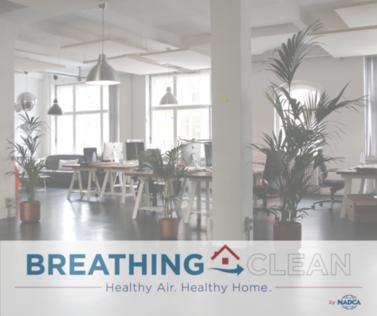Sick Building Syndrome – Air Quality and Allergens in the Workplace
Regardless of how much hand sanitizer you use, sometimes avoiding the illnesses circulating the office is inevitable. Sickness can strike from time to time, but what if you are feeling under the weather every time you’re at work? It is possible that the air quality in your office is the culprit for you and your co-workers’ symptoms. One out of four buildings in the US can be classified as a “sick building” and the effects may be more serious than you would think. 
What is Sick Building Syndrome?
The EPA defines Sick Building Syndrome as “situations in which building occupants experience acute health and comfort effects that appear to be linked to time spent in a building, but no specific illness or cause can be identified.” Individuals may be healthy, but after spending time in a sick building they may experience certain side effects including:
- lack of energy
- irritated eyes
- inability to concentrate
- headaches
- eye irritation
The symptoms and severity of Sick Building Syndrome may vary from person to person depending on their sensitivity to airborne allergens. Breathing polluted air may not immediately affect some, but it may cause respiratory diseases in the long run.
What are the causes of Sick Building Syndrome?
Sick Building Syndrome can stem from causes such as inadequate ventilation, chemical contaminants, or a buildup of allergens. Examples of these allergens are:
- mold
- mildew
- pollen
- dust mites
A buildup of these containments can occur in the air ducts of office buildings and, as air circulates through the ducts, the containments are blown around and distributed throughout the building. This causes the people within the building to be continuously exposed to the allergens and air pollutants.
What is the cost of Sick Building Syndrome?
Sick Building Syndrome creates bigger issues than just giving employees a stuffy nose. According to The American Lung Association, US adults miss about 14 million workdays per year because of asthma, which is an issue commonly triggered by poor indoor air quality
- According to the EPA, almost $60 billion dollars are lost in productivity due to poor indoor air quality
- Sick Building Syndrome can affect workers ability to productively and efficiently do their jobs, which can add up to be a major loss for employers. Reducing sick building symptoms through properly maintained HVAC systems can lead to $10-$30 billion in productivity gains, better indoor air quality, and happier and healthier employees.
How can NADCA help?
A solution to correct and prevent Sick Building Syndrome is to ensure the ventilation systems are cleaned on a regular basis. A NADCA member company can help with that.
HVAC contract companies who are members of NADCA follow a higher standard in air duct cleaning and customer service. With advanced training and certifications in HVAC system hygiene, you can rest assured that they’ll be able to diagnose and suggest the proper plan of action to lessen the Sick Building Syndrome symptoms that occupants may be experiencing.
Interested in getting the process started? To find a NADCA member company near you, visit the Find a Professional directory on the NADCA website.
